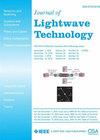Optical Communications in Autonomous Driving Vehicles: Requirements, Challenges, and Opportunities
IF 4.1
1区 工程技术
Q2 ENGINEERING, ELECTRICAL & ELECTRONIC
引用次数: 0
Abstract
The automotive industry is currently undergoing a revolution. Electrification, automation, and connectivity become major trends in future vehicles. Autonomous driving vehicles require a variety of sensors to perceive their surroundings and rely on high-speed and reliable intra-vehicle networks (IVNs) for data transmission. As the number and performance of sensors increase and the IVN evolves from distributed architecture to domain centralized and zone centralized architecture, the demand for IVN data rates escalates. Optical fiber communication is a promising solution in IVN due to its high bandwidth, light weight, and good electromagnetic compatibility. However, the harsh environment in vehicles such as wide temperature range, vibration, dust and grease contamination poses a great challenge to employ optical fiber communication in IVN. To tackle this issue, novel intra-vehicle optical network configurations and technologies have been proposed. In addition, the development of vehicle-to-everything (V2X) communication technology will further improve road safety and traffic efficiency. Optical wireless communication can offer advantages over radio frequency technology for V2X communication.求助全文
约1分钟内获得全文
求助全文
来源期刊

Journal of Lightwave Technology
工程技术-工程:电子与电气
CiteScore
9.40
自引率
14.90%
发文量
936
审稿时长
3.9 months
期刊介绍:
The Journal of Lightwave Technology is comprised of original contributions, both regular papers and letters, covering work in all aspects of optical guided-wave science, technology, and engineering. Manuscripts are solicited which report original theoretical and/or experimental results which advance the technological base of guided-wave technology. Tutorial and review papers are by invitation only. Topics of interest include the following: fiber and cable technologies, active and passive guided-wave componentry (light sources, detectors, repeaters, switches, fiber sensors, etc.); integrated optics and optoelectronics; and systems, subsystems, new applications and unique field trials. System oriented manuscripts should be concerned with systems which perform a function not previously available, out-perform previously established systems, or represent enhancements in the state of the art in general.
 求助内容:
求助内容: 应助结果提醒方式:
应助结果提醒方式:


